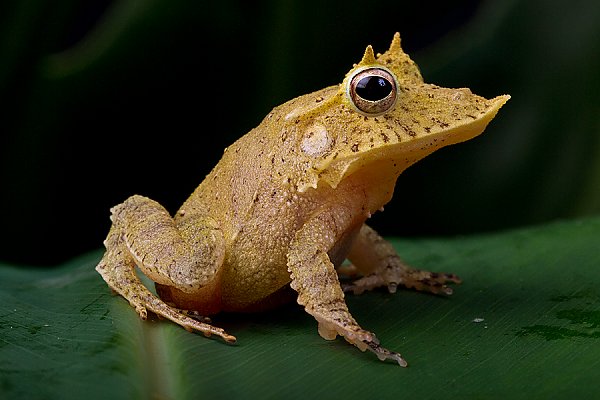Solomon Island Leaf Frog
Ceratobatrachus guentheri
Solomon Island leaf frogs get their name from being found mainly in the Solomon Islands and their cryptic coloration and shape that camouflages them well in decaying leaves. They are medium-sized frogs with colors ranging from gold to earthy browns to green. These frogs are one of the few frogs with no tadpole stage. Tolerating a variety of habitats, this species is very abundant and not currently threatened.

Solomon Island Leaf Frog *Ceratobatrachus guentheri* Credit: Brian Gray/Aquarium of the Pacific
SPECIES IN DETAIL
Solomon Island Leaf Frog
Ceratobatrachus guentheri
CONSERVATION STATUS: Safe for Now
CLIMATE CHANGE: Not Applicable
At the Aquarium
The Solomon Island leaf frog resides in the large free-standing cylinder in the Frogs: Dazzling and Disappearing exhibit area in the Tropical Pacific Gallery.
Geographic Distribution
Solomon Islands and Papua New Guinea, Bougainville, and Buka Islands.
Habitat
Solomon Island leaf frogs inhabit rainforests of montane and tropical lowland forests with low amounts of standing water. It lives in leaf litter on the forest floor and tolerates a wide variety of habitats, so they may be found in degraded lands or rural gardens.
Physical Characteristics
This medium-sized terrestrial frog has many color variations ranging from gold to earthy browns to green. It has a triangular head with a somewhat flattened body and wrinkles and veins covering its skin. The protuberance sticking out from the end of its snout and a spike sticking up above each eye enhance its leaf shape.
Size
Average size is 3 to 4 inches (7.6 to 10 cm) long for females. Males are slightly smaller.
Diet
These frogs feed on insects, smaller amphibians, including other frogs, small reptiles, and arthropods.
Reproduction
These frogs have no set breeding season. Males use their loud, bark-like call to attract females. After mating the female will lay pea-sized clear eggs in small shallow pits dug out by the frog at the base of a tree. After about a month, the eggs will hatch into fully developed frogs measuring 1/8 inch (3 mm) in length.
Behavior
These nocturnal frogs are ambush predators, meaning they sit and wait for prey to come into their vicinity before attacking.
Adaptation
Their camouflage allows them to blend into decaying leaf matter on the rain forest floor making it difficult for predator or prey to see them.
Longevity
While their lifespan in the wild is unknown, they typically live three to five years in captivity.
Conservation
The current population is abundant and stable, possibly due to their ability to adapt to a wide variety of habitats. This frog is being exported in large numbers for the pet trade. The Solomon Islands government is considering legislation to control exports. Habitat loss is becoming more of a threat due to logging.
SPECIES IN DETAIL | Print full entry
Solomon Island Leaf Frog
Ceratobatrachus guentheri
CONSERVATION STATUS: Safe for Now
CLIMATE CHANGE: Not Applicable
The Solomon Island leaf frog resides in the large free-standing cylinder in the Frogs: Dazzling and Disappearing exhibit area in the Tropical Pacific Gallery.
Solomon Islands and Papua New Guinea, Bougainville, and Buka Islands.
Solomon Island leaf frogs inhabit rainforests of montane and tropical lowland forests with low amounts of standing water. It lives in leaf litter on the forest floor and tolerates a wide variety of habitats, so they may be found in degraded lands or rural gardens.
This medium-sized terrestrial frog has many color variations ranging from gold to earthy browns to green. It has a triangular head with a somewhat flattened body and wrinkles and veins covering its skin. The protuberance sticking out from the end of its snout and a spike sticking up above each eye enhance its leaf shape.
Average size is 3 to 4 inches (7.6 to 10 cm) long for females. Males are slightly smaller.
These frogs feed on insects, smaller amphibians, including other frogs, small reptiles, and arthropods.
These frogs have no set breeding season. Males use their loud, bark-like call to attract females. After mating the female will lay pea-sized clear eggs in small shallow pits dug out by the frog at the base of a tree. After about a month, the eggs will hatch into fully developed frogs measuring 1/8 inch (3 mm) in length.
These nocturnal frogs are ambush predators, meaning they sit and wait for prey to come into their vicinity before attacking.
Their camouflage allows them to blend into decaying leaf matter on the rain forest floor making it difficult for predator or prey to see them.
While their lifespan in the wild is unknown, they typically live three to five years in captivity.
The current population is abundant and stable, possibly due to their ability to adapt to a wide variety of habitats. This frog is being exported in large numbers for the pet trade. The Solomon Islands government is considering legislation to control exports. Habitat loss is becoming more of a threat due to logging.

